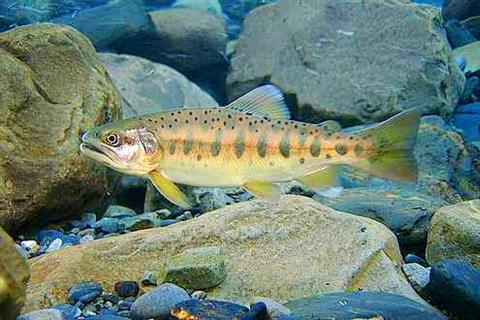Salmon is a migratory fish, born in an upstream river freshwater environment, from where it migrates to the sea. The adult fish then swims back upstream to the place of its birth to reproduce. It is a cold-water fish, living in temperate zones.
A species left over from the Ice Age

Photo courtesy of a reader
照片:讀者提供
Formosan landlocked salmon is a subspecies of the Pacific salmon, living in subtropical Taiwan. This makes the subspecies endemic to Taiwan. The mountain formation that took place 15,000 years ago, at the end of the Ice Age, blocked the way to the sea. This is how the salmon became landlocked.
Formosan landlocked salmon is, then, unique to Taiwan’s mountain rivers, a relic of the Ice Age. It is an example of an “ice age relic species,” a rare “living fossil.” It is known as a “national treasure fish.”

Photo courtesy of Shei-Pa National Park Administration Office
照片:雪霸國家公園管理處提供
Extinction crisis
Formosan landlocked salmon thrives in rivers 2,000 meters above sea level, in waters not exceeding 17 degrees Celsius throughout the year. During the winter months, temperatures of about 10 degrees Celsius are needed for breeding. Large volumes of fresh, uncontaminated water are also crucial.
In 1995, the numbers of Formosan landlocked salmon had dwindled to 200. The species was on the verge of extinction.

Photo courtesy of Shei-Pa National Park Administration Office
照片:雪霸國家公園管理處提供
According to the Shei-Pa Park Administration Office, typhoon flooding and fragmented habitats caused by global warming, as well as farming activity, have all taken their toll on the survival of Formosan landlocked salmon.
Shei-Pa Park conservation efforts
Since its establishment in 1992, the Shei-Pa National Park has been actively engaged in conservation efforts. Through cultivation and restoring the historical habitat, the Formosan landlocked salmon in the Qijiawan River can now reproduce. According to the latest research, published on March 15, there are now 5,059 Formosan landlocked salmon in the river. This is close to the river’s maximum capacity of 5,800. This species, with its long history, can once more thrive in Taiwan.
(Translated by Lin Lee-kai, Taipei Times)
鮭魚是洄游性魚類,在河流的淡水環境中出生後,移居大海成長;長成後會從大海溯河而上,回到牠出生的河流上游繁殖。鮭魚屬冷水魚,生活在溫帶地區。
冰河時期遺留之物種
「櫻花鉤吻鮭」是太平洋鮭屬的鮭魚亞種,卻生長在亞熱帶的台灣,是台灣特有亞種。這是因為一萬五千年前冰河時期末期,台灣地形隆起成高山,使得原本在台灣的鮭魚因地形阻隔,而成為「陸封型」魚種。
因此櫻花鉤吻鮭是冰河時期遺留在台灣高山溪流的特殊魚種,為「冰河孑遺生物」代表之一,是稀有的活化石,而有「國寶魚」之稱。
瀕臨絕種危機
櫻花鉤吻鮭的生存條件,須為海拔兩千公尺處,終年河水最高溫不能超過攝氏十七度,冬天必須有十度左右的低溫,適合繁殖;最重要的是水源充足,未遭汙染破壞。
據一九九五年統計,櫻花鉤吻鮭族群數量僅剩兩百尾,瀕臨絕種。
雪霸國家公園管理處指出,颱風洪水是衝擊鮭魚族群生存的關鍵因素。另外,在全球氣候暖化及高山農業耕種等影響下,櫻花鉤吻鮭生存的棲地破碎,也是原因。
雪霸公園復育工作
雪霸國家公園自一九九二年成立以來積極進行復育,透過人工繁殖配合棲地復舊保育,目前七家灣溪流域的櫻花鉤吻鮭已能自我繁衍。本月十五日發布的最新研究成果顯示,鮭魚數量已達五○五九尾,接近溪流的五八○○尾承載量,成功保存此萬年物種。
(台北時報林俐凱整理)

Rehearsal time is over. The world’s best and most ambitious young pianists have descended on Warsaw for the Frederic Chopin International Piano Competition — for some, a gateway to classical music glory. Fans from around the globe snapped up tickets as much as a year ago. The lucky ones attended the opening night concert on Oct. 3 and will follow along as the contest builds to a thrilling climax on Oct. 20. Winning the Chopin International — held every five years in the 19th-century composer’s homeland — can raise the curtain to playing at venues across the globe and signing contracts

A: K-pop supergroup Blackpink is finally touring Taiwan again. B: I can’t believe we’re going to Blackpink’s concert at the Kaohsiung National Stadium over this weekend. A: The group has caused a global sensation since it went international in 2020. B: And the four members — Jisoo, Jennie, Rose and Lisa — have achieved success as solo artists. A: Seeing them live will be like a dream come true. A: 韓流天團Blackpink終於又來台巡演啦。 B: 真不敢相信我們這週末要去她們在高雄國家體育場的演唱會。 A: 該團自2020年進軍國際,便持續造成全球轟動。 B: 而4位團員––Jisoo、Jennie、Rose、Lisa––單飛也很成功。 A: 這次能去她們的演唱會真是美夢成真! (By Eddy Chang, Taipei Times/台北時報張迪)

Many popular English expressions originate from the world of sports. While their roots lie in athletics, their meanings extend far beyond the playing field. Here are three examples. Hat Trick This expression comes from cricket. When a bowler dismisses a batter, it’s called “taking a wicket.” Taking three wickets in a row is a great achievement, so in the past, a bowler who achieved this was rewarded with a hat. Later, sports like hockey and soccer adopted it to mean scoring three goals in a game. Nowadays, this phrase means to achieve any three successes consecutively, not just in sports. For example,

A: Is K-pop still popular now? B: Sure! The 110,000 tickets for supergroup Blackpink’s two shows to be held this weekend were all snatched up within three minutes. A: Apart from Blackpink, what other K-pop stars are visiting? B: I-dle’s Taiwanese member Yeh Shu-hua, King of K-pop G-Dragon, and Super Junior are all coming soon next month. A: Super Junior’s 2009 hit “Sorry, Sorry” boosted this Korean “Hallyu” to a peak. Let’s go experience SJ’s magic again. A: 韓國流行音樂還是很受歡迎嗎? B: 當然啦,光是天團Blackpink本週末兩場演唱會,11萬張門票3分鐘內就被秒殺! A: 除了Blackpink,還有哪些韓國歌手最近會來台? B: I-dle的台灣成員葉舒華、韓流天王G-Dragon權志龍、Super Junior下月也都將來台。 A: Super Junior 2009年金曲《Sorry, Sorry》曾將「韓流」推上高峰,我們再去重溫一下SJ的魔力吧。